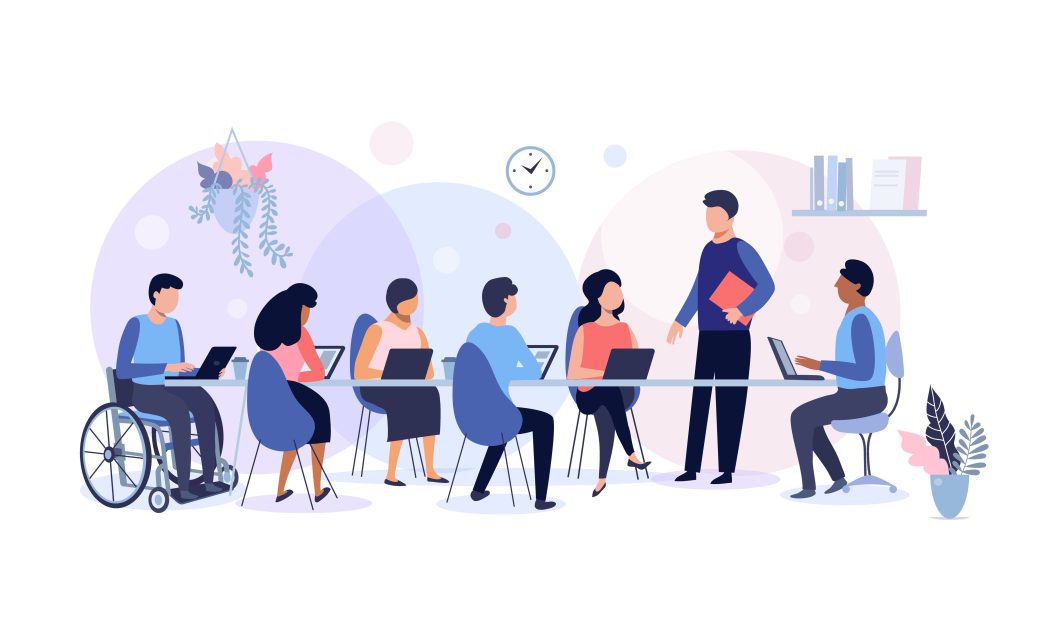The purpose of this research is to develop a safe, inclusive environment with the I/DD Community, not for the I/DD Community.
“My disability exists not because I use a wheelchair, but because the broader environment isn’t accessible” – Stella Young
Facilitators:
Dr. CJ Cook, DBA, MBA, Manager of Community Engagement, Inland Regional Center (IRC)
Marquis Quinton, Inland Regional Center (IRC) Emergency Services Coordinator (ESC)
Estefania “Fania” Pena, Inland Regional Center (IRC) Cultural Specialist, Deaf and Hard of Hearing(D/HH)
Martin Morales, MPA, Inland Regional Center (IRC) Language Access and Cultural Competency (LACC) Specialist
Inland Regional Center (IRC)
Inland Regional Center (IRC) is the foundation for greater independence for people with developmental disabilities in the Inland Empire. IRC is a non-profit agency that has provided support to people with intellectual disabilities, Autism, cerebral palsy, and epilepsy since 1972. Today, IRC provides case management and service coordination for more than 47,000 clients in Riverside and San Bernardino Counties (IRC, 2021).
IRC receives funding from the Department of Developmental Services (DDS) to employ an individual who acts as an Emergency Services Coordinator (ESC). IRC’s ESC interprets all current emergency operational procedures and protocols that impact the Intellectually and Developmentally Disabled (I/DD) Community and the network of service providers at IRC. The ESC also responds to man-made or natural disasters that negatively impact the I/DD Community (Cook, 2022; IRC, 2021).
Introduction
As a system of care designed to protect the Intellectually and Developmentally Disabled (I/DD) Community, we can prevent the negative effects of a natural or man-made disaster when they strike and prepare for them before they occur (Kelman, 2020). It is understood that the negative impact of a natural disaster deeply impacts the I/DD Community within the State of California (Cook, 2022, Elisala et al., 2020; Simpson et al., 2021). Many of the Clients served by the Regional Center System of Care struggle from day to day and are often ignored and overlooked in aspects of community planning and readiness (Rubin et al., 2019; Villeneuve et al., 2021).
According to the Department of Homeland Security (DHS), disaster preparedness is characterized as an uninterrupted cycle of events that are intended to reduce the negative consequences on the population during a disaster. This cycle of events includes drills conducted by local, state, federal, or tribal governments, planning meetings, and community training. Preparedness also incorporates the individual’s disaster materials, such as water, medical supplies, and adequate food (Cook, 2022). The American Red Cross (2020) contends that a person is well prepared when they understand the destructive force of a disaster, have a well-developed and practiced evacuation plan, possess a go-bag, and stay informed.
Intellectual and Developmental Disability (I/DD)
The Lanterman Act, in conjunction with California Welfare and Institutions Code (WIC) Section 4512, is utilized to define I/DD and establishes five categories that may qualify an individual for services from a Regional Center (IRC, 2022). Therefore, the Lanterman Act and WIC Section 4512 formally identify that an individual diagnosed with autism spectrum disorder (ASD) or an intelligence quotient (IQ) of 70 or below are intellectually disabled (ID), as well as individuals diagnosed with epilepsy or cerebral palsy (CP) as developmentally disabled (DD). The above mentioned may receive services from the Regional Center System of Care after eligibility has been established. An individual with a condition that is like or requires similar treatment to IQ below 70 is also classified as ID, which is referred to as the fifth category of eligibility (Cook, 2022; Lanterman, 2021; WIC 4512, 2021). An individual with a substantial I/DD will have challenges learning and communicating needs, identifying dangers, lack mobility and often require professional assistance with self-direction, identifying dangers in the community and living independently (Cook, 2022; IRC, 2022).
Significance of the Focus Groups
Often little to no warning is provided when a disaster strikes, and the unforeseen changes along with the absence of thorough disaster preparedness causes safety concerns within the I/DD Community (Cook, 2022; Ducy & Stough, 2021; NCDP, 2021). Within California, the twenty-one Regional Centers, their network of service providers and the State of California Department of Developmental Services (DDS) serve over 400,000 individuals from birth to the end of life with an I/DD who may be negatively impacted in a disaster.
A legitimate fear of the I/DD Community is that their basic needs will not be met in times of crisis. These needs include adequate disaster planning, training, effective communication in primary language and drills which in turn promote disaster preparedness. The I/DD Community must be included in all facets of disaster preparedness to support in preparing for a natural or man-made disaster before one occurs. This inclusion can empower the I/DD Community in the creation of comprehensive disaster plans that will save lives (Black & Draper, 2019, Cook, 2022, Elisala et al., 2020; Simpson et al., 2021).
Focus Groups
The in-person focus groups were held in San Bernardino City, Blythe, Victorville, and Rancho Cucamonga, CA. The San Bernardino session utilized a Certified Deaf Interpreter to facilitate the process. No caregivers were in the focus groups to ensure the participants’ voices were heard. The participants were asked fourteen open-ended questions in the same order for each focus group. The questions were specifically designed to trigger conversation with the participants to assist in the data collection process.
Data was collected from thirty-five IRC Clients aged 18 to 57 years old with an active IRC case. Also, the participants attended either a community-based program or supported employment funded by IRC. The participants also either lived independently with or without support from IRC or in a licensed board and care. Three of the participants’ primary language was American Sign Language (ASL) and lived in a board and care while attending an adult day program.
Results
Based on the interaction with the focus group participants and the lived experiences they shared, the below results are respectfully presented.
Overall, Clients are not adequately prepared for a natural or man-made disaster despite the on-going efforts to offer information, training and guidance from IRC.
Participants who had Received Training
In one particular focus group, all the Clients had attended a disaster preparedness, active shooter class the previous month. Those Clients had forgotten or were unaware of many of the training points presented, had not signed up for Public Safety Power Shutoff (PSPS) alerts and none remembered what IRC used Everbridge Mass notification system for. Furthermore, most Clients in the group did not know where to reunite with family if a natural or man-made disaster were to occur. On a positive note, all the Clients who had attended the IRC training had received a disaster preparedness go-bag provided by a grant from the E. Rhodes and Leona B. Carpenter Foundation.
D/HH Clients
Due to language challenges associated with language deprivation syndrome, a well-documented problem facing the Deaf and Hard-of-Hearing Community, and often exacerbated by intellectual and developmental disabilities, printouts of items related to the questions were made available in advance to minimize miscommunication. A certified Deaf interpreter (CDI) and a team of ASL interpreters were present to facilitate effective communication. IRC D/HH Specialist was made aware that some focus group questions were difficult to translate effectively in a visual-spatial language from a spoken language without additional visual contexts or expanding on details. Two of three Clients repeatedly demonstrated they did not understand the questions and duplicated their peers’ responses. Additionally, they needed helpful visual prompts or rephrased questions from facilitators to better produce responses.
The findings from this focus group are concerning. None of the Clients had a smartphone and would not be prepared to call for help in cases of emergency. They were not aware of the text-911 option and Everbridge, or how to sign up for PSPS alerts. The Clients were probed on why they did not have a smartphone. Two Clients cited unaffordability as a reason, and another stated he was not allowed to have one and was surprised to learn that phones are accessible. Those Clients expressed interest in training on the use of smartphones and video relay services (VRS). Moreover, none of the Clients understood the significance of the strobe alarm systems that were installed in their board and care, mistaking them as flashing alarms meant to wake clients and not as an emergency notification system. The Clients did not know what to do beyond carrying out basic fire and earthquake drills and indicated they would require outside support to guide them to safety.
Overall
Overall, the Clients who participated in the focus group identified many barriers. One such barrier was an inability to have spare money to place in the go-bag. As well, the Clients didn’t have the needed extra medication to place in the go-bag. Clients who wore glasses stated they do not have a spare pair of glasses. Those Clients who had not received a go-bag from IRC cited the cost of purchasing or building a bag as too expensive.
When exploring food and water required to be prepared for a disaster, many of the Clients do not have the required water, food, or other necessary supplies to maintain them for a period of more than seven days. Finally, the Clients were unaware of many systems in place to ensure they are aware of PSPS, evacuations or pending disasters.
Action to be Taken by IRC
Disaster Preparedness Advisory Committee
IRC will create a disaster preparedness advisory committee made up of clients, service providers and the Emergency Services Coordinator (ESC). Furthermore, this committee will be led by IRC’s Client Advocates who have received appropriate training in disaster preparedness, to assist the ESC in all aspects of the creation of clear and concise training materials.
Peer to Peer Disaster and Active Shooter Training for IRC Clients
IRC Client Advocates will go through a train the trainer process led by the Manager of Community Engagement and the IRC ESC. Once trained, the Client Advocates will create a presentation covering disaster preparedness training. Also, active shooter training will be developed using the Run, Hide, Fight model. Both the trainings will be in simple language and driven by videos, in English and ASL, and personal stories used to educate and engage IRC Clients.
Public Safety Power Shutoff (PSPS)
Public Safety Power Shutoff (PSPS) events may place individuals who rely on electricity for treatment devices in jeopardy because of equipment failures (Molinari et al., 2017). The equipment failure is usually Durable Medical Equipment (DME), such as electric wheelchairs, oxygen machines, electric beds, adaptive communication devices or nebulized medications for breathing treatments (Cook, 2022; Webb et al., 2021).
IRC’s ESC will review and update how Clients are communicated with and prepare for a PSPS event. Furthermore, IRC will revamp the PSPS training provided to Clients, staff, and vendors. IRC’s ESC will explore generic resources to ensure Clients who use DMEs, or nebulized medications have a backup battery.
IRC’s Client Advocates, in collaboration with the ESC, will perform training with IRC Clients, parents, caregivers, vendors and community stakeholders on how to access PSPS alerts. This training will be offered in-person and virtually as needed throughout the year.
Emergency Services Resource Page inlandrc.org
In our efforts to help our Clients prepare for a natural or man-made disaster, IRC recognizes that emergency preparedness as a concept should be presented in a manner that is easy to comprehend, easy to access and constantly encouraged. As one of the first interactions many will have with the emergency preparedness initiatives at IRC, the ESC resource page is intended to be a platform that incorporates an introduction to basic emergency preparedness concepts, provides basic resources for Clients to prepare for themselves, keeps people informed of IRC trainings and emergency preparedness initiatives and connects them with the ESC.
Everbridge Education
Everbridge is a mass notification system used by IRC during emergency situations to provide real-time information to Clients, vendors, and staff. Everbridge allows IRC to communicate emergency alerts such as evacuation orders or weather warnings, resource information such as shelters or food distribution points, and receive feedback from Clients as to any unmet needs or threatening situations. Based on our focus group interactions, discussions with staff, and our own use of the system, it has become apparent that many people do not fully understand how the system is used, the expected responses to it, or are aware of its existence in the first place. As such, IRC has begun to conduct reoccurring trainings throughout the year for Clients, staff and vendors about the system and how we use it. This is particularly important as IRC only uses Everbridge in response to official declarations of emergency or alerts from emergency channels.
Disaster Go-Bags Distribution
In partnership with the Department of Developmental Services (DDS) and Disability Rights California (DRC), IRC offers comprehensive emergency preparedness training for Clients in Independent Living (IL) or Supportive Living (SL) settings who also live in risk areas of wildfire. The training is offered virtually in a classroom setting, or in a self-paced individual format, as well as in person through the ESC or Client Advocates. Topics include Staying Informed of Emergencies, Making an Emergency Plan, Creating an Emergency Kit, and Practicing Your Plan. Attendees of this training also receive a fully stocked basic emergency preparedness kit to help with preparation. With the development of this training, we eventually hope to extend its availability to all IRC Clients.
Communication Cards
Deaf Access Specialists (DAS) and Emergency Services Coordinators from several Regional Centers have partnered with DDS Emergency Management Services to develop accessible, user-friendly communication cards for all D/HH Regional Center Clients. The communication cards are intended to serve as tools to provide emergency communication access to D/HH Clients to become informed and quickly act when critical information is relayed in real-time. The cards incorporate pictorial icons with accompanying text based on categories of basic communication, medical/health needs, and emergency information to meet basic communication and safety needs, and are designed to be convenient in design and functionality. The testing of the cards on their effectiveness will be piloted among D/HH Clients to allow for any possible changes prior to their first official distribution. It is possible a How-To training video in ASL will be produced to explain its purpose and uses.
D/HH Community Training
Maximizing emergency preparedness communication access for the deaf and hard-of-hearing (D/HH) populations is critical. Without emergency communication access, deaf people can experience serious injury or death. For instance, communication warns people about natural disasters, public health epidemics, and other large-scale emergencies such as terrorist attacks; but deaf and hard-of-hearing people are often excluded from communication before, during, and after emergencies. Another challenge to be considered is that the communication needs of the deaf and hard-of-hearing populations vary depending on the level of hearing loss and cultural orientation. Given that first responders often do not know how to communicate with people with barriers to literacy, language, culture, or disability, educating and empowering the D/HH Clients and families to take more action can foster resilience and may tackle the lack of communication access during an emergency (Engleman, 2012).
Providing various workshops in partnership with Deaf-serving Community Based Organizations (CBOs) and Emergency Services personnel on emergency preparedness may increase the ability of IRC Clients to become better prepared and confident before actual emergencies occur. The training should involve hands-on activities such as role-playing during mock scenarios, how to pack their go-bag, how to draw a map for evacuation, and how to use communication cards or write pre-messages for first responders. This training allows Clients the ability to use their hands, learn, and be ready. Families can be invited to support their Clients.
By working with Deaf-serving CBOs, emergency services personnel simultaneously get hands-on experience in engagement with the diverse deaf and hard-of-hearing populations and receive cultural training. Cultural training can be provided by either IRC Cultural Specialist or Deaf trainers with expertise working in emergency response and action systems.
Lessons Learned from the Snowstorm of 2023
Recently the San Bernardino Mountains experienced an unprecedented winter storm that dropped over 100 inches of snow over the course of about a week. The storm forced a full mountain closure – meaning that all access roads to mountain communities were shut down, and no travel was permitted in either direction. Several mountain communities found themselves forced to shelter-in-place until emergency crews could clear roads to allow access, and many in those communities found themselves without adequate supplies of food or medication. In the community of Crestline, the only grocery store in the area had its roof caved in due to the accumulation of snow. Additionally, several communities experienced power outages during below-freezing temperatures.
This is a good example of how emergency situations, even with prior notice, can compound to affect those within the I/DD Community in disproportionate ways – for example, people who are dependent on electrical medical devices, sensitive to extreme temperatures, or dependent on outside medical care, could easily find themselves marginalized during this type of event. However, with simple preparation, many of the problems residents in the mountain communities faced during the storm could have been easily mitigated. The fact that the storm caught so many off guard, including first responders, shows great room for improvement in terms of emergency preparedness awareness and practices – especially within the I/DD Community.
Conclusion
Individuals within the I/DD Community often live in isolation from the general population, struggle from day to day, and are frequently ignored and overlooked in many aspects of community planning and readiness (Cook, 2022; Rubin et al., 2019; Villeneuve et al., 2021). Moreover, it is well established that individuals with an I/DD have considerable limitations that impede their ability to not only respond to a natural or man-made disaster but also prepare for one (Black & Draper, 2019). Additionally, IRC fully acknowledges a lack of overall preparedness in the D/HH Community and is dedicated to decreasing this disparity over the next year with the proposed actions to be taken.
During a natural or man-made disaster, the local communities are immobilized by damage to critical infrastructures, which in turn places the residents in danger. Recently the San Bernardino Mountains experienced an extraordinary winter storm that dropped over 100 inches of snow over the course of about a week. The storm forced a full mountain closure – meaning that all access roads to mountain communities were shut down, and no travel was permitted in either direction. This unexpected snowstorm exposed safety concerns within the I/DD Community and revealed a lack of preparedness.
Most emergency response systems are created for people who can read, speak, hear, see, and move. Direct input from the I/DD Community helps us identify and address the disparities in these systems. Therefore, IRC will provide informational materials, training and events that speak to the unique needs of the I/DD Community.
IRC’s commitment to preparing those we serve is a notable goal as the agency moves into FY 23/24. Moreover, IRC wholeheartedly believes in a shared responsibility approach to disaster preparedness. This will require the Clients, vendors, parents and CBO’s to utilize information provided, attend training when offered, and utilize the knowledge provided before the disaster occurs. The I/DD Community must be prepared and understand the power of a natural or man-made disaster to not only react, but survive and recover (Dutta, 2017).
References
ARC. (2022). How to Prepare for Emergencies.
Black, K., & Draper, P. (2019). Nothing about us, without us: An inclusive preparedness programme for the whole community from inception to sustainment. Journal of Business Continuity & Emergency Planning, 13(2), 136-149.
Cook, C. (2022). Investigating Emergency Operational Procedures and Protocols in the Regional Center System in California: A Qualitative Explanatory Case Study
DHS. (2021). Natural Disasters.
Elisala, N., Turagabeci, A., Mohammadnezhad, M., & Mangum, T. (2020). Exploring persons with disabilities preparedness, perceptions and experiences of disasters in Tuvalu. PLoS ONE, 15(10) https://doi.org/10.1371/journal.pone.0241180
Engelman, Anna. (2012). Addressing Disparities in Emergency Communication with the Deaf and Hard-of-Hearing: Cultural Competence and Preparedness for First Responders
IRC. (2021). Emergency Service Coordinator (ESC). https://www.inlandrc.org/careers/
Kelman. (2020). Disaster by Choice: How Our Actions Turn Natural Hazards into Catastrophes. OUP Oxford.
Molinari, N. A. M., Chen, B., Krishna, N., & Morris, T. (2017). Who’s at risk when the power goes out? The at-home electricity-dependent population in the United States, 2012. Journal of Public Health Management and Practice, 23(2), 152.
Rubin, I. L., Falk, H., & Mutic, A. D. (2019). Natural disasters and vulnerable populations: A commentary. International Journal of Child Health & Human Development, 12(4), 303-318.
Simpson, N., Pérez, R., & Goldberg, M. (2021). Semi-structured interviews on disaster and emergency preparedness for people with disabilities in two states in Mexico. Natural Hazards, 106(1), 1037. https://doi.org/10.1007/s11069-021-04508-z
Villeneuve, M., Abson, L., Pertiwi, P., & Moss, M. (2021). Applying a person-centred capability framework to inform targeted action on Disability Inclusive Disaster Risk Reduction. International Journal of Disaster Risk Reduction, 52 https://doi.org/10.1016/j.ijdrr.20 20.101979
Webb, E., Balaji, L., Nathanson, L. A., Balsari, S., & Dresser, C. (2021). Who’s at risk in a changing climate? Mapping electricity-dependent patient populations in a coastal city. Rhode Island Medical Journal (2013), 104(9), 14-19.
Share this Post




